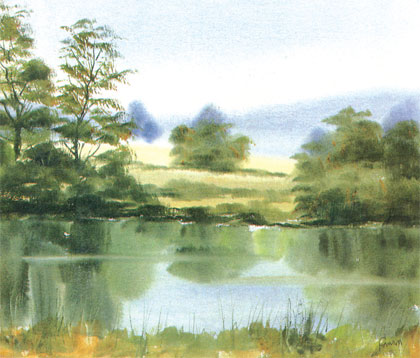|
Learn to draw by Tissa Hewavitarane:
Combining techniques provides textural contrast
We have looked at basic watercolour techniques of wash, wet-into-wet
and dry brush strokes. They all have their strengths and weaknesses.
Wash, for example, is the most positive way of indicating shapes. Its
strength lies in its simplicity, but it can get a bit monotonous.
|

A scene with wet-into-wet technique |
Wet-into-wet is the most spontaneous and exciting, but too much of it
can be vague and look like candyfloss. Calligraphy is decorative and
descriptive but can look fussy if overdone. A dry brush when used with
restraint can provide sparkle. All these techniques when combined in one
painting provide a whole armoury of textural contrasts.
The combination overcomes the inherent limitations of each and they
all complement one another. In my own paintings I endeavour to contrast
the stroke made by each of the three types of brush that I use - the
enforced simplicity, softness and directness of the brush against the
crisp hard-edged precision of the flats and the fine delicacy of the
rigger.
One could say it is rather like an orchestra with the big, bold, rich
brass contrasting with the mellow strings and the clear tones of the
reed instruments to form a complete and satisfying all-over sound.
Wet-into-wet is particularly useful for putting in a line of distant
trees. I paint the sky down to the horizon and while it is still wet.
Usually a fairly light blue up into the sky from the horizon. Never use
wet-into-wet for foregrounds, they must at least be crisp and sharp,
otherwise it will look as if you are wearing glasses. Looking at many
paintings, I find that wet-into-wet techniques have formed an important
part in most of them, perhaps because they always seem to sell well.
You should experiment to discover all the many techniques available.
Push, stroke, or even pat the brush on the paper, so that the hairs
barely graze it. The dry brush has many uses - to suggest the bright
shimmer of the sun on water, the texture of pebbles on the shore, the
rough bark on the tree trunk or the weathered surface of a plaster wall.
Do practise these techniques, although it probably won't come off at
first. |

